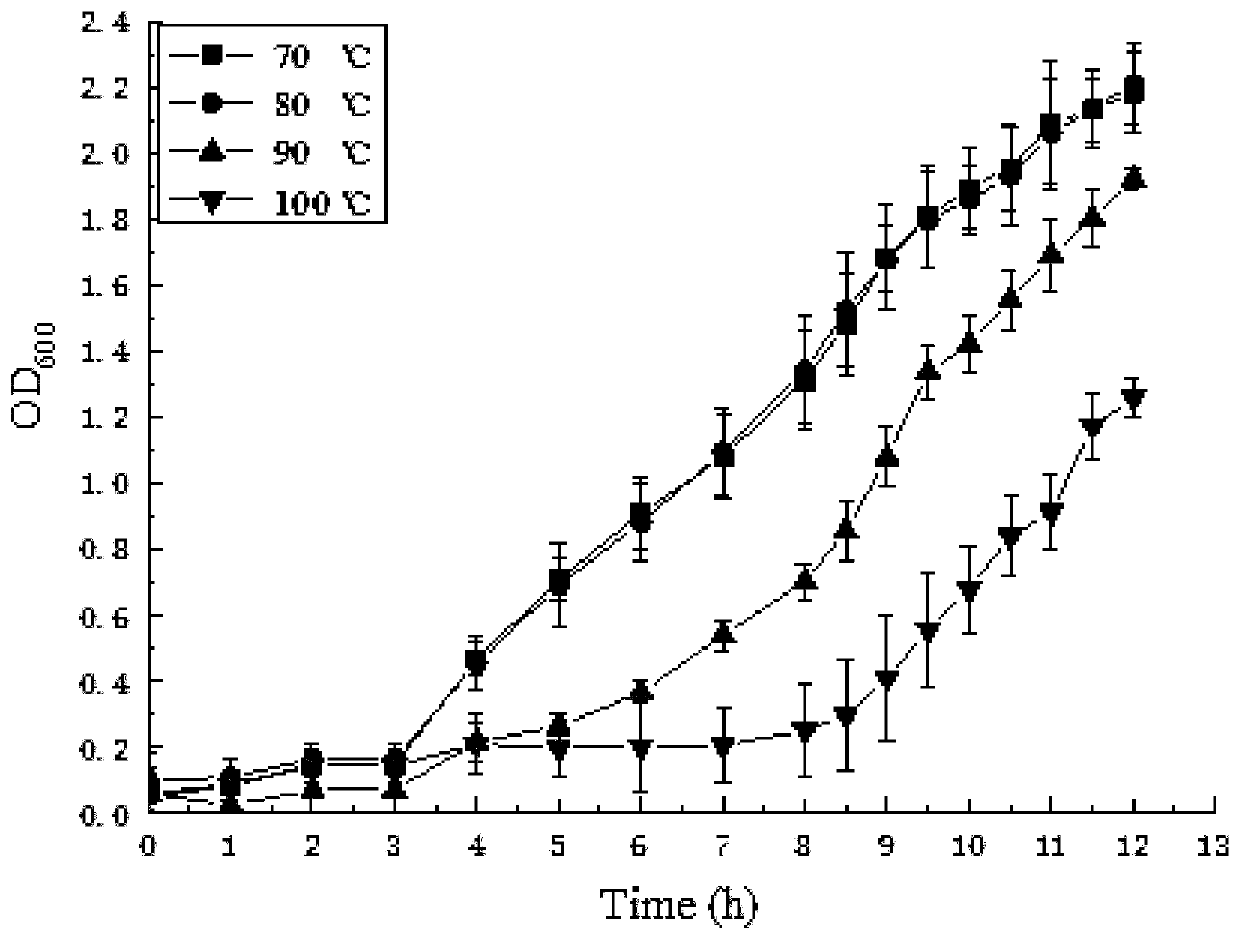Extremely thermophilic bacteria and application thereof in high-temperature composting fermentation
A kind of thermophilic and bacterial technology, which is applied in the field of microbial technology and environmental engineering, can solve the problems of shortage and difficulty in reaching a higher fermentation temperature, and achieve the effects of saving time and cost, accelerating putrefaction, and increasing compost temperature
- Summary
- Abstract
- Description
- Claims
- Application Information
AI Technical Summary
Problems solved by technology
Method used
Image
Examples
Embodiment 1
[0056] Embodiment 1: Food waste composting treatment
[0057] Take 5 tons of food waste, cut and stir to make it into pieces with a diameter of about 3cm. Put the pieces into the fermentation device, add 3% quicklime, 0.5g esterase, 0.8g cellulase, 0.4g alkaline amylase, 0.5g alkaline protease, control the moisture content of the material at about 80%, and stir evenly Then stand still for 0.5h. Then put 1.5 tons of GW-2 bacterial agent into the fermenter (when making, the volume ratio of fermentation broth to dry wood chips is 1:0.9), stir evenly and start heating. After 0.5h, the temperature in the fermenter reaches 45°C. After maintaining the heating for 3 hours, the temperature rises to 60°C, the heating is stopped, and the high-temperature composting stage is entered at this time. After 20 hours, the temperature rose to 100°C and the humidity dropped to 75%. After 24 hours, the temperature in the fermenter began to decrease slowly, and dropped to 60°C after 44 hours. At...
Embodiment 2
[0058] Example 2: Farming solid waste composting
[0059] Take 10 tons of pig farm feces, put in 4.5% quicklime, stir evenly, control the moisture content of the material at 82%, put in 0.8g esterase, 1.3g cellulase, 0.3g alkaline amylase, 0.8g alkaline protease and continue Mix and stir, turn on the electric heating to raise the temperature to 45°C and maintain it for 1h. Put in 4 tons of GW-2 bacterial agent sawdust, (during production, the volume ratio of fermentation liquid to dry sawdust is 1:0.8), stir well, increase the electric heating power to raise the temperature to 45°C, and start high-temperature composting. After 4 hours of start-up, the temperature of the compost heap rose to 65°C, and gradually increased within 24 hours of start-up, and finally reached 85-100°C, and the humidity gradually decreased from the initial 80% to about 53%. Then the temperature dropped slowly, and the temperature dropped to 65°C within 48 hours of starting. At this time, 20% of the vo...
Embodiment 3
[0060] Example 3: Fertilizer composting of agricultural by-products
[0061] Take 5 tons of straw, add it to the fermentation device with cutting and stirring, and continuously cut and stir it into pieces of about 6cm, put in 5% quicklime, stir evenly, control the moisture content of the material at 85%, put in 0.7g esterase, 1.3g cellulase , 0.6g alkaline amylase, and 0.5g alkaline protease continued to mix and stir, and turned on the electric heating to raise the temperature to 45°C and maintain it for 2h. Put in 2.5 tons of GW-2 bacterial agent sawdust, (during production, the volume ratio of fermentation liquid to dry sawdust is 1:1), stir well, increase the electric heating power to raise the temperature to 45°C, and start high-temperature composting. After 4 hours of start-up, the temperature of the compost heap rose to 60°C, and gradually increased within 24 hours of start-up, and finally reached 85-100°C, and the humidity gradually decreased from the initial 87% to abo...
PUM
 Login to View More
Login to View More Abstract
Description
Claims
Application Information
 Login to View More
Login to View More - R&D
- Intellectual Property
- Life Sciences
- Materials
- Tech Scout
- Unparalleled Data Quality
- Higher Quality Content
- 60% Fewer Hallucinations
Browse by: Latest US Patents, China's latest patents, Technical Efficacy Thesaurus, Application Domain, Technology Topic, Popular Technical Reports.
© 2025 PatSnap. All rights reserved.Legal|Privacy policy|Modern Slavery Act Transparency Statement|Sitemap|About US| Contact US: help@patsnap.com

